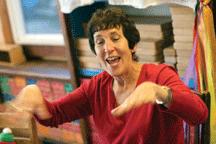
Judy Sima found her voice as a storyteller almost 30 years ago. She says when she first heard storytellers she was “blown away” by their ability to capture the audiences’ imagination and attention. She immediately knew this is what she wanted to do.
At the time, she was a library media specialist for schools in the Detroit area with a master’s degree in library science, so she told stories evenings or during vacations. When she retired in 2004, she could then be a full-time storyteller.
“Kids who wouldn’t listen to me telling about the Dewey Decimal System all of a sudden were hanging on my every word, they were engrossed by the stories,” she says. “So it’s just a powerful way of communicating.”
The stories Sima tells either come from books that have captured her imagination or stories she creates herself. Some come from Jewish folktales. She likes stories where she can get the audience involved and also ones that grab children’s attention to the point where they’re really focused on the story.
“I like stories where they stop breathing because they’re so engrossed and so intent on the story that they don’t breathe,” says the 72-year-old storyteller. “I guess I like performing in front of an audience and when I can have them in the palm of my hand, it makes me feel good and I think it’s good for the audience.”
One of her original stories, “The Boy Who Drew Cats,” is included in the anthology “August House Book of Scary Stories.” And she has recently written a book with co-author Kevin Cordi, “Raising Voices: Creating Youth Storytelling Groups and Troupes,” published by Libraries Unlimited, which has received numerous awards. It’s available on her website, www.JudySima.com.
The book is a guide for adults to teach children to tell stories and how to perform them, with lots of activities to help them and a bibliography of other books and articles. She says the title, “Raising Voices,” came from her co-author.
“It just seemed kind of like what we’re doing — we’re raising the kids just like you raise your own children or raising our students, but also helping them find their voices,” says Sima.
She has also written numerous articles for journals and magazines about storytelling.
Sima says storytelling is far different than just reading to an audience. With storytelling, there’s a connection between you and your audience. A book is a barrier between the reader and the audience.
She searches the globe for stories to help children appreciate that despite our differences, people the world over have the same needs, fears and desires. Her ultimate goal, she says, is to show that whether it’s a story from the United States, China, Japan, or anywhere else, children will relate to the differences. Because she’s a librarian, she says 99 percent of these stories come from books and her interpretation of them.
Sima began coaching students and adults to become storytellers about 20 years ago. As a librarian, she says, if she finds a good book, something that she likes, she has to share it.
“I have to connect people and I have to connect ideas, so for me it’s very important,” she explains. “And when I found that storytelling built my confidence and made me feel so good about myself, I wanted to share that with my students.”
But working full time at schools, she just didn’t have the time. So she started a group called Parent Tellers that she coached, and they would go to classrooms and tell stories.
“It’s such a wonderful art form and it’s just so gratifying for the storyteller that I just couldn’t keep it to myself,” says Sima.
She does a lot of workshops on how to do storytelling, which is why she’s coming to Kansas City. She has been invited to be one of the featured tellers at The Kansas City Storytelling Celebration from noon to 3 p.m. Wednesday, Nov. 2, at Maple Woods Community College. For more information, go to http://www.kcstorytelling.org/. The workshop is for teachers and librarians.
Sima says she is looking forward to being at Congregation Beth Torah to tell the story of her mother’s escape from Nazi Germany. (See box for details.) This is very important to her, she explains, because it’s a way to honor her mother’s memory. She has told the story at schools, libraries and churches, as well as Jewish organizations.
She believes her mother’s story also helps children understand the Holocaust better because it’s hard to wrap your head around 6 million people perishing. But hearing one person’s story becomes understandable.
Through research, Sima has had to build on what little her mother told her because her parents didn’t talk much about that part of their lives. When she began storytelling, her mother had developed Alzheimer’s so she couldn’t elicit many details. The story keeps evolving as she learns more information about what went on at that time, she says.
She found out that both sets of her grandparents perished in the Holocaust, as well as her mother’s brother. She says her mother always felt guilty that she couldn’t bring her brother here. She never knew what happened to him or her parents.
“I tell the story in first person as if I’m my mother, which brings me a closer connection to the story and I think also to my audience, and it helped me shape the story,” says Sima. “I focus on her leaving Germany, coming to America and confronting the Gestapo, just that period of her life.”
She says her mother always said something good came out of the Holocaust — there would not have been the state of Israel without it.
“(Holocaust survivors) always seemed to look on the positive side of things,” she says. “I think that’s part of the human spirit. We survive; we do the best we can.”



